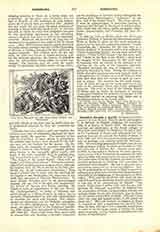

Cornelius Cornelii a Lapide (CORNELIS CORNELISSEN VAN DEN STEEN), Flemish Jesuit and exegete, b. at Bocholt, in Flemish Limburg, December 18, 1567; d. at Rome, March 12, 1637. He studied humanities and philosophy at the Jesuit colleges of
Maastricht and Cologne, theology first, for half a year, at the University of Douai, and afterwards for four years at Louvain; he entered the Society of Jesus, June 11, 1592, and, after two years’ novitiate and another year of theology, was ordained priest December 24, 1595. After teaching philosophy for half a year, he was made professor of Holy Scripture at Louvain in 1596 and next year of Hebrew also. Twenty years later, in 1616, he was called to Rome in the same capacity, where, on the 3rd of November, he assumed the office which he filled with such renown for many years after. The latter years of his life, however, he seems to have devoted exclusively to finishing and correcting his celebrated commentaries. He was a sincerely pious and zealous priest and an exemplary religious. During his professorship at Louvain he liked to spend his holidays preaching and administering the sacraments, especially at the pilgrimage of Scherpenheuvel (Montaigu). With moving simplicity and truth he portrayed himself in an emotional prayer to the Prophets at the end of his commentary on Daniel: “For nearly thirty years I suffer with and for you with gladness the continual martyrdom of religious life, the martyrdom of illness, the martyrdom of study and writing; obtain for me also, I beseech you, to crown all, the fourth martyrdom, of blood. For you I have spent my vital and animal spirits; I will spend my blood too.” With his brethren in religion at Rome he enjoyed so high a reputation for sanctity that, when he died, they gave him a separate burial place, in order to be the more certain of finding his bones when eventually, as they hoped, he should receive the honor of beatification.
Cornelius a Lapide wrote ample commentaries on all the books of the Catholic Canon of Scripture, with the exception only of Job and the Psalms. Even before leaving Flanders, he edited the “Commentaries in omnes divi Pauli epistolas” (1614) and “ill Pentateuchum” (1616), both at Antwerp. The commentaries on the Greater and Lesser Prophets, on the Acts of the Apostles, the Canonical Epistles and the Apocalypse, Ecclesiasticus and the Proverbs, followed later on. The rest were edited only after his death; but all of them have been several times reedited, both separately and collectively. Of the Commentary on the Epistles of St. Paul he himself was permitted to see at least eleven editions. The complete series, with Job and the Psalms added by other hands, appeared at Antwerp, 1681, 1714; at Venice, 1717, 1740, 1798; at Cologne, 1732; at Turin, 1838; at Lyons, 1839-42, 1865 and 1866; at Malta, 1843-46; at Naples, 1854; at Lyons and Paris, 1855 and 1856; at Milan, 1857; at Paris, 1859-63. The last-mentioned edition has been enriched by Crampon and Peronne with many annotations from more recent interpreters. All these commentaries are on a very large scale. They explain not only the literal, but also the allegorical, tropological, and anagogical sense of the sacred text, and furnish a large number of quotations from the Fathers and the later interpreters of Holy Writ during the Middle Ages. Like most of his predecessors and contemporaries, a Lapide intends to serve not only the historical and scientific study of the Bible, but, even more, the purposes of pious meditation, and especially of pulpit exposition. An extract from the commentary on the Acts appeared in 1737 at Tyrnau, under the title: “Effigies Sancti Pauli, sive idea vitae apostolicie”. A large work in 4 vols., “Les tresors de Cornelius a Lapide: extraits de ses commentaires de l’ecriture sainte a l’usage des predicateurs, des communautes et des families chretiennes”, by the Abbe Barbier, was published at Le Mans and Paris, 1856, reedited at Paris, 1859, 1872, 1876, 1885, 1896; and an Italian translation of the same, by F. M. Faber, appeared at Parma, 1869-70, in 10 vols., 16 mo.
These numerous editions show how highly these works are estimated by Catholics. But Protestant voices have joined in the appreciation. G. H. Goetzius (Leipzig, 1699) wrote an academical dissertation, “Exercitatio theologica de Cornelii a Lapide Commentariis in Sacram Scripturam”, in which he praises the Jesuit author as the most important of Catholic Scriptural writers. An English translation of the complete commentaries was undertaken by the Rev. Thomas W. Mossman, an Anglican clergyman, under the title, “The great Commentary of Cornelius a Lapide” (London, 1876). A manuscript in the Vatican Library contains an Arabic translation of the Commentary on the Apocalypse, by Yusuf ibn Girgis (beginning of the eighteenth century). The same Maronite writer is said to have translated the Commentary on the Epistles of St. Paul
JOHN P. VAN KASTEREN

